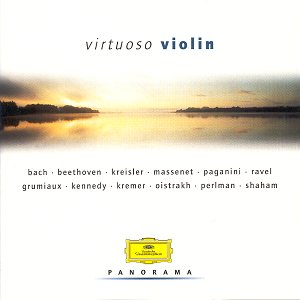VIRTUOSO VIOLIN
Jules MASSENET
Thaïs: Méditation (1)
Ludwig van BEETHOVEN
Romance no.1 in G, op.40, Romance no.2 in F, op.50 (2)
Fritz KREISLER
Liebesfreud, Liebesleid, Schön Rosmarin (3)
Nicolò PAGANINI
Capricci, op.1: 6, 17, 1, 9, 24 (4), Violin Concerto no.2 in b, op.7:
Finale - "La Campanella" (5) |
Giuseppe, TARTINI arr. Kreisler
Sonata in g, op.1/4 - "The Devil's Trill (6)
Johann Sebastian BACH
Partita in d, BWV 1004: Chaconne (7)
Ludwig van BEETHOVEN
Sonata in F, op.24 - "Spring" (8)
César FRANCK
Sonata in A (9)
Maurice RAVEL
Tzigane (10) |
 VIOLINISTS:
Salvatore Accardo (4, 5), Arthur Grumiaux (3, 6), Kennedy (1), Gidon Kremer
(8), David Oistrakh (2), Itzhak Perlman (9), Gil Shaham (10), Henryk Szeryng
(7) VIOLINISTS:
Salvatore Accardo (4, 5), Arthur Grumiaux (3, 6), Kennedy (1), Gidon Kremer
(8), David Oistrakh (2), Itzhak Perlman (9), Gil Shaham (10), Henryk Szeryng
(7)
PIANISTS: Martha Argerich (8), Vladimir Ashkenazy (9), Riccardo Castagnone
(6), István Hajdu (3), Gerhard Oppitz (10)
ORCHESTRAS: London Philharmonic Orchestra (5), National Philharmonia Orchestra
(1), Royal Philharmonic Orchestra (2)
CONDUCTORS: Richard Bonynge (1), Charles Dutoit (5), Sir Eugene Goossens
(2)
 DG PANORAMA 469 235-2 [2
CDs 71.36+76.09] DG PANORAMA 469 235-2 [2
CDs 71.36+76.09]
Crotchet
AmazonUK
AmazonUS |

A brief but to-the-point introduction to the development of the violin and
its music, plus a chronological line, give way to the more listener-friendly
sequence listed above. The first disc is divided evenly between the violin
at its most sweetly soothing and its scope for fiendish virtuosity, the second
gives us four substantial, well-contrasted pieces. A progression from easy
listening to real exploration and appreciation, and the listener who wishes
to take that step and has a predilection for the violin may find this collection
really helpful.
Poor performances would have rendered the exercise vain, but here we have
some of the finest violinists of the recent past and present. Perhaps Shaham
and Oppitz try too hard with the Ravel Tzigane while achieving less
than some who treat it more mellifluously, but for the rest these are some
of the most distinguished recordings of these works in the catalogue. It
is interesting that the contrast between the various styles of violin-playing
which might have been expected is less noticeable than the overall consistency.
All the artists are concerned with making the instrument sing without exaggerated
vibrato or portamenti and adopt a straightforward non-interventionist approach
to the music (yes, Kennedy included). It would be almost invidious to single
out the separate items, but Oistrakh's very rich, full tone was an especial
pleasure (the more so since so much of his art is preserved on sub-standard
Russian recordings), and so were two quite exceptional collaborations; Kremer
and Argerich in Beethoven and Perlman and Ashkenazy in Franck.
Not so long ago I was remarking with regard to a Brendel set on Vox that
one of the hallmarks of a great pianist is that every note has its importance.
Listen to Argerich in the Beethoven slow movement. Her left hand may be playing
something not much more elaborate than an Alberti bass, but each note has
a wonderful luminosity, revealing this to be the foundation from which the
melodic lines, both hers and the violinists, derive. And also with Ashkenazy
I would like to draw attention to the slow movement, for it is not particularly
surprising that he negotiates with ease all the semi-quaver passages in the
second and fourth movements which many an enthusiastic academy student has
splashed his way through. But listen, rather, to the sweet luminosity of
his chording as the Recitativo-Fantasia opens, and to how, as the piano part
flowers into triplets, the non-harmony notes are placed like pebbles gently
dropped into a pool of water, each one leaving its mark behind it. And hear
how this partnership gives real shape to a movement which can seem harder
to bring off than the others, where so often sheer enthusiasm can carry the
day.
Presumably the seasoned collector will have or want these performances in
their original context but this is an extremely well-planned anthology for
the sector of the public at which it is aimed.
Christopher Howell
|
|

